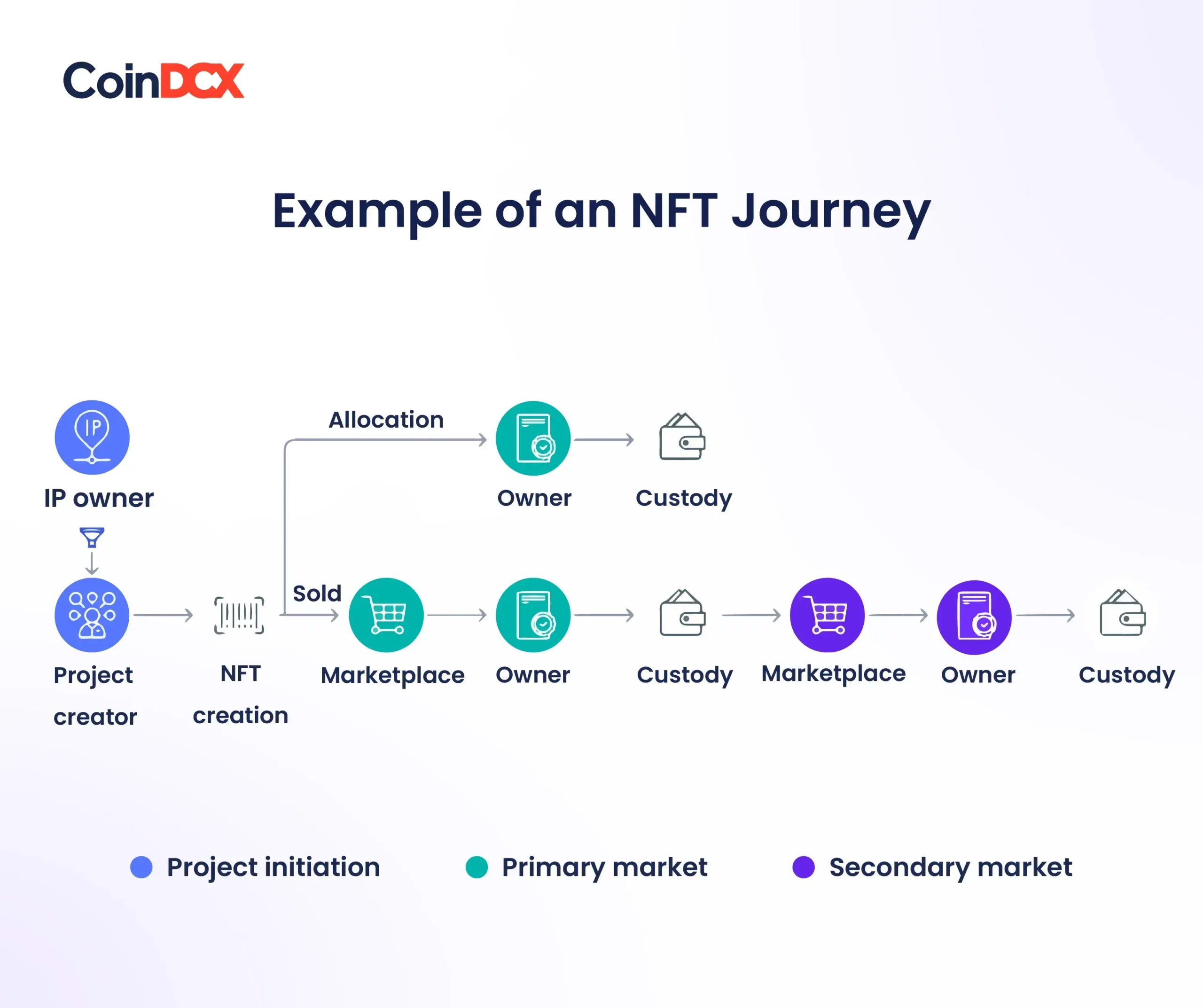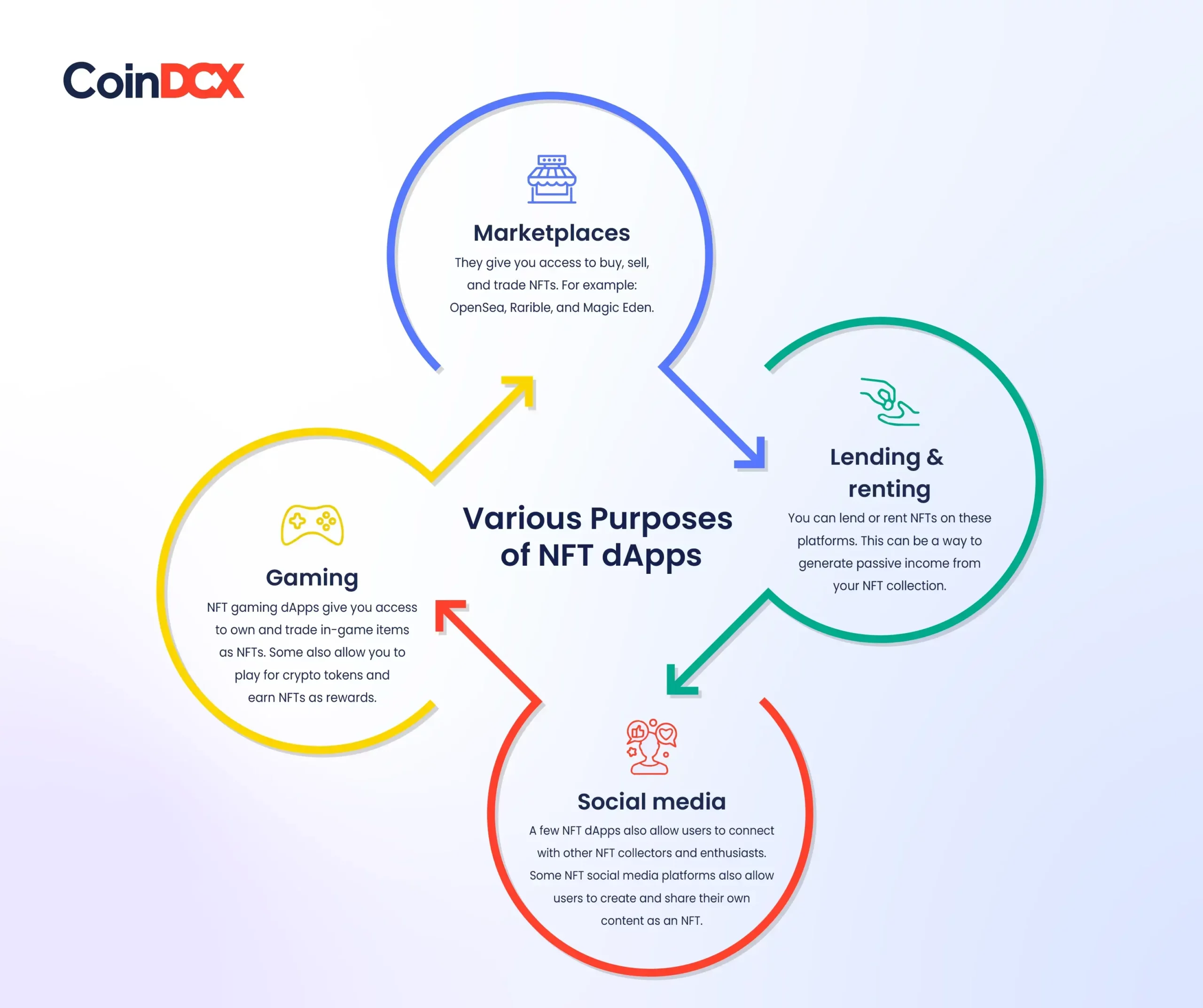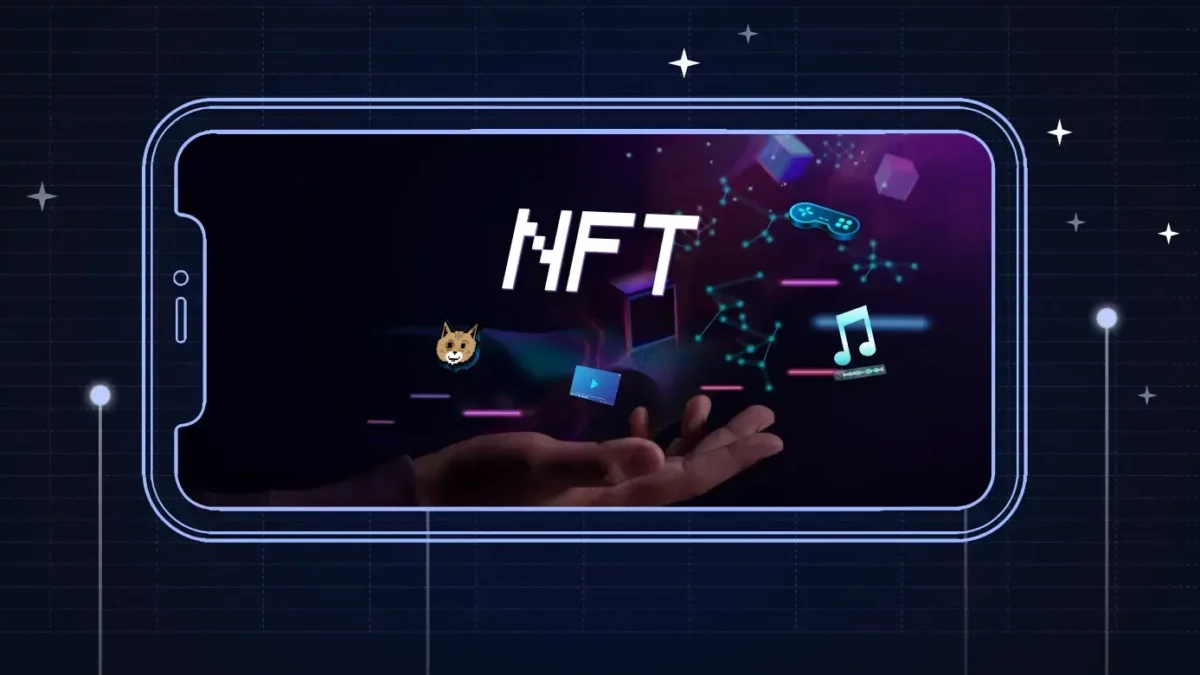Table of Contents
ToggleIntroduction
In the ever-evolving landscape of digital assets and decentralized technologies, Non-Fungible Tokens (NFTs) and Decentralized Applications (DApps) have emerged as transformative innovations. NFTs have gained immense popularity for representing ownership of unique digital items, while DApps have revolutionized traditional applications by operating on decentralized networks. In this blog post, we delve into the synergistic relationship between NFTs and DApps, exploring their functionality, benefits, drawbacks, and the steps involved in creating NFT DApps.
NFTs and DApps — More Than Just Digital Cousins
Decentralized applications (DApps) and non-fungible tokens (NFTs) stand as integral elements within the blockchain and crypto ecosystems. Despite their distinct functionalities, there are instances where they intersect, creating a symbiotic relationship.
NFTs find application in DApps, serving as indicators of ownership or access rights for tangible and digital assets. DApps, in turn, utilize NFT standards like ERC-721 or ERC-1155 to tokenize unique items such as in-game assets, digital art, or real estate.
Gaming DApps often leverage NFTs to represent in-game assets, which can be traded and bought on secondary markets. This practice enhances the concept of genuine ownership and fosters compatibility across various virtual worlds or games.
Additionally, the surge in NFT popularity has given rise to DApps tailored for creating, managing, and trading digital assets. By tokenizing their creations, artists and content creators generate distinctive digital assets that consumers can buy, sell, and own. This dynamic has empowered creators to directly engage with their audience, offering collectors a secure and verifiable means of digital asset ownership.
The programmable nature of smart contracts plays a pivotal role in the convergence of DApps and NFTs. DApps leverage smart contracts to automate numerous NFT-related tasks, including content licensing, royalty distribution, and the implementation of dynamic features within the NFT itself. This heightened programmability enhances the utility and functionality of NFTs within decentralized applications.

What are NFT Dapps?
Simply put, applications built on the blockchain by incorporating non-fungible tokens are referred to as NFT DApps. Through these applications, individuals can generate, acquire, vend, and exchange unique digital assets, spanning from artwork and collectibles to in-game items. NFT DApps empower gamers, artists, and content creators, harnessing the transparency and security inherent in blockchain technology to revolutionize ownership.
Read More: What is an Open Edition NFT?

The significance of NFT DApps resides in their ability to establish a decentralized marketplace, promote direct transactions between peers, introduce novel ownership structures, challenge established industries, and democratize entry into the worldwide digital economy.
Benefits of NFT dApps
| Aspect | Description |
|---|---|
| Decentralization | NFT dApps operate on blockchains, ensuring they remain uncontrolled by any single entity. Furthermore, being open-source projects, their code is accessible for public scrutiny and auditing. |
| Transparency | All transactions within dApps are recorded on the blockchain, providing public visibility. This transparency fosters trust and confidence among users by allowing them to verify transactions independently. |
| Privacy | Interactions with dApps do not necessitate the sharing of personal information. Users retain ownership of their data and have the freedom to disconnect their wallet from a dApp, opting for an alternative at any time. |
| Efficiency | NFT dApps can surpass traditional applications in efficiency by eliminating the need for intermediaries and streamlining processes and transactions. |
| Meaningful Ownership | NFT dApps introduce unique functionalities not feasible with traditional applications. For instance, NFT gaming dApps enable users to possess and trade in-game items as digital assets. |
Drawbacks of NFT dApps
| Challenge | Description |
|---|---|
| Complexity | NFT dApps may pose challenges in usability, especially for users unfamiliar with crypto and decentralized applications. |
| Cost | High gas fees associated with Ethereum, where most NFT dApps reside, can render them expensive during periods of increased network traffic. |
| Smart Contract Risks | As a relatively new technology, dApps are susceptible to security risks, including hacking and scams. Users need to be cautious while navigating this evolving landscape. |
5 Types of NFT Dapps
NFT DApps cover diverse platforms, addressing specific aspects of the digital and blockchain realms.
- Art and Collectibles Platforms: Artists tokenize creations on platforms like OpenSea and Rarible, transforming them into marketplaces for buying, selling, and exchanging original digital assets, empowering artists in the blockchain ecosystem.
- Gaming and Virtual Worlds: DApps like Decentraland and CryptoKitties use NFTs to represent in-game items, fostering a dynamic virtual economy and introducing concepts like play-to-earn in blockchain-based gaming.
- Virtual Real Estate: Platforms for virtual real estate allow users to develop, profit, buy, sell, and trade virtual land and property, sparking interest in user-owned, decentralized virtual worlds and potential advancements in digital property rights.
- Marketplaces: Essential to the NFT ecosystem, marketplaces like Foundation and Mintable provide means for artists to mint and showcase NFTs globally, serving as intermediaries connecting creators and fans and contributing to the NFT industry’s expansion.
- Decentralized Finance (DeFi) and NFT Collateral: Beyond creativity, NFTs enter DeFi through DApps like Aavegotchi and Rarible, exploring NFT integration as collateral. This allows users to lend or borrow funds based on their NFT holdings, unlocking new possibilities at the intersection of digital ownership and decentralized finance.
Step-by-Step Guide to Create a NFT Dapp
Whether defining your concept, choosing the blockchain, or engaging with your community, every step is vital in creating a unique NFT dApp that stands out in the competitive market. From coming up with the idea to selecting the right technology and connecting with users, we’ll explore each crucial stage in building a successful NFT DApp. Let’s navigate from the beginning:
- Define the Concept: Thoroughly establish the NFT DApp’s concept, defining goals, target users, and distinctive features that set it apart in the competitive NFT market.
- Choose the Blockchain: Select the appropriate blockchain platform, with Ethereum being a popular choice due to its established infrastructure and broad support for NFT standards like ERC-721 and ERC-1155.
- Set Up the Development Environment: Install necessary dependencies and tools, including smart contract development kits and blockchain development frameworks, to create a conducive development environment.
- Develop Smart Contracts: Create smart contracts governing NFT distribution, creation, and ownership, outlining terms and features such as minting, purchasing, selling, and transferring.
- Integrate a Wallet: Connect wallets like MetaMask or Trust Wallet to enable users to securely manage their NFTs and interact with the DApp via crypto wallets.
- Implement Minting Functionality: Develop an intuitive UI for creators to upload their work, add metadata, and mint NFTs. Additionally, implement features for purchasing, selling, and trading, including auctioning, bidding, and real-time pricing adjustments.
- Test and Deploy: Thoroughly test the NFT DApp for flaws or vulnerabilities before deploying it to the blockchain. Once satisfied, deploy related files and smart contracts on the selected blockchain for global user accessibility.
- Launch and Marketing: Strategically release well-crafted smart contracts over the mainnet to officially launch the NFT DApp. Implement a comprehensive marketing strategy to increase exposure, including sharing a captivating story across forums, social media, and crypto communities.
- Website Development: Establish a central information center with a user-friendly interface on a well-thought-out website. Provide guidelines to help new users navigate the platform.
- Community Engagement: Implement a robust community feedback loop during the launch phase to swiftly address user complaints and foster a positive community environment.
- Post-Launch Communication: Maintain an open line of communication with users, respond to issues, and adapt the DApp to evolving market dynamics following the launch
Read On: How to Create an NFT on OpenSea?
Is it Difficult to Create an NFT dApp?
Developing and launching an NFT DApp does come with a few challenges. The primary challenge lies in technical scalability, driven by the massive demand and intricate nature of NFT transactions. Ensuring a seamless user experience becomes crucial, demanding inventive solutions to address potential network congestion and delays in transaction processing.
Security for smart contracts is paramount, given that vulnerabilities could have lasting impacts on users and compromise the integrity of NFTs. Moreover, distinguishing oneself in a saturated market, where numerous NFT DApps vie for user attention, adds another layer of complexity.
Navigating legal uncertainties, particularly concerning intellectual property rights and regulatory compliance, introduces another challenge. Successfully overcoming these obstacles requires a meticulous blend of technological expertise, robust security measures, user-centric design, and a keen understanding of the evolving regulatory landscape surrounding NFTs.
Know More: Did the NFT Bubble Burst Yet?
Conclusion
As you explore the dynamic realm of NFT DApps, the prospect of opting for a White Label solution emerges as a beacon of efficiency and innovation. More than just a shortcut, it represents a strategic decision that enables you to concentrate on your strengths — crafting, curating, and engaging your audience within the decentralized landscape.
Related posts
Understanding the Different Types of Cryptos: Coins, Tokens, Altcoins & More Explained
Explore the major types of crypto assets and their unique roles.
Read more
PAWS Telegram Game: The New Tap to Earn Game That Is Beating Hamster Kombat
Discover how to play and earn with PAWS Telegram game.
Read more


